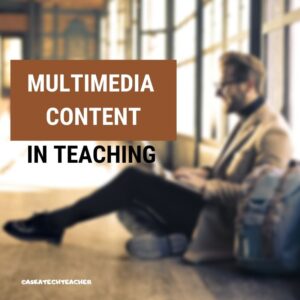Ask a Tech Teacher contributor, Josemaría Carazo Abolafia, is an educational researcher and teacher who lives in Spain–and doesn’t own a car! He has a Masters in Ed from Penn State University (any Nittany Lion fans out there?) and is working on his EdD. Josemaria and I share the belief that “…[technology] must be transparent, like a lens; otherwise, it hinders learning.” Here’s his take on the use of videos in education:
Multimedia content as a way to learning process personalization

People can learn more deeply from words and pictures than from words alone. It can be called the multimedia learning hypothesis (Mayer, 2005). My experience teaching with videos supports the idea that students not only learn more deeply but also faster. Consequently, the syllabus can be enlarged when classes take advantage of multimedia means -as it happened.
Moreover, multimedia content helps to individualize the learning process for every student, who really can learn at its own pace.
The multimedia content that I use consists of about 250 videos. Most of them are between 2 and 5 minutes long. Each video contains an explanation that happened during a real class, recording what students were watching -classrooms have a projector- and listening. They can be checked out at http://youtube.com/ldts1. It might be important to point out that my students are 17 years old and over.
However, using multimedia content to elicit learning does not lack inconveniences. The same problems that hinder learning when using textbooks occur when using videos. On the other hand, the same techniques can be useful in both cases. A constructivism insight and the cognitive load theory ground the solutions proposed to avoid those inconveniences.
Three difficulties when using multimedia content
I mainly found 3 difficulties when using videos as the main learning content format:
-
- Reception overload. More frequently than wished, the student doesn’t get the gist of an explanation on video format, and she or he has to re-watch the video 1, 2 or even 3 times. There’s no doubt, it’s frustrating for anyone.
- Lack of learner’s intervention. Passivity.
- Lack of variety -not related to the content but the format: video, text, website, lecture, and so on.
Based on several learning theories, I focused on 3 ways to tackle these problems.
I. The schematization of content in videos
Cognitive load theory states that the main limit we have when receiving information is set by our working memory. In particular, this problem has to do with duration and size. The working memory cannot retain many bits of information. If a number were to be fixed, we would be talking about 3, maybe 4 elements. A longer sequence of information and bits will need some assistance. For example, the alphabet is memorized by making packages of 2, 3 or 4 letters, like ABC-DFG-… This idea is supported by several experiments. (Gagné, Yekovich, C. & Yekovich, F., 1993).
No matter what the format is, the content may easily saturate the working memory. Being so, special techniques may be useful, as they are with the alphabet. Those techniques mainly imply structure, scheme, and length.
The scheme is a key element in the process of memorization. Information is much more easily retained when it is packetized and there is a logic that connects those packs of information among them, composing a whole. In other words, they “appear to be an adaptive way to reduce the load on working memory” (p. 81). In textbooks, for instance, elements to facilitate memorization are frequent.
The structure is tied to a pre-known scheme, which probably was in the author’s mind. That structure is shown with signals, like epigraphs and paragraphs, the same as in this very article. Said that, we may easily agree that:
-
- The video has to be divided into several parts, according to the scheme.
- Changing from one part to the following has to be signaled, with, for instance, transitions and titles.
Apart from schematization, there are 2 more things to take into account, regarding working memory:
-
- The duration of the video has to be adequate for the learner.
- The pace should be without unnecessary or annoying pauses. At this point, video editing and cutting may be very beneficial.
Regarding video length, his experience supports that the least is the best, as long as the structure is clear. Long videos make fade learner’s attention.
II. Interactivity instead of passivity
Depending on the content, videos may be combined with practice in a watch-and-do or do-and-compare fashion. It fits with exercise explanations and procedural learning, like software implementation.
One more step that can be taken, by making videos interactive. It prevents passivity in the learning process, by interrupting videos with questions that challenge the learner’s understanding. Therefore, proper questions make learning deeper, and they help to check and fix the comprehension of the underlying scheme.
There are several software solutions to make videos interactive. I have successfully used H5P and Edpuzzle.
III. The variety and the cooking analogy
It is most interesting that, once we came back to traditional lectures when class explanations were important, students were asked if they wanted that explanation to be recorded, and they always said yes. Therefore, we may conclude that the combination of several ways for content delivery probed to be the best solution. In another article, I have called this the cooking analogy: no matter how one particular ingredient is. A tasteful meal always implies a magistral combination of ingredients. So it is with learning.
My particular dish is currently published on a website using WordPress with Learnpress, H5P and some other plugins. It combines text, images, and exercises with the more than 200 videos. You can give it a look at https://lab.ldts.es.
I would like to finish with a comment written to a video on Youtube: “what I didn’t understand after three classes, I just got in ten minutes.” The original in Spanish, at https://www.youtube.com/watch?v=xjKHRS_LlrI.
+Theory:
Gagné, Ellen D., Yekovich, Carol W. & Yekovich, Fran R. (1993). The Cognitive Psychology of School Learning. Addison Wesley Longman. 2nd Edition.
Mayer, R. E. (2005). Introduction to Multimedia Learning. The Cambridge handbook of multimedia learning, (pp. 1-24).
Bio and Contact info
Josemaría Carazo Abolafia is a vocational training teacher living in Seville, southern Spain, born in a small city called Jaén. He loves teaching, cycling and walking -which is why he sold his car 6 years ago. He deeply enjoys teaching, and trying to find the best way to facilitate learning. He feels quite comfortable using technology in the classroom, but at the same time believes it must be transparent, like a lens; otherwise, it hinders learning.
Email: josemaria@alumni.psu.edu
Website: https://lab.ldts.es/
More on videos in ed
9 Good Collections of Videos for Education
Ways to use a movie for language teaching
Jacqui Murray has been teaching K-18 technology for 30 years. She is the editor/author of over a hundred tech ed resources including a K-12 technology curriculum, K-8 keyboard curriculum, K-8 Digital Citizenship curriculum. She is an adjunct professor in tech ed, Master Teacher, webmaster for four blogs, an Amazon Vine Voice reviewer, CSTA presentation reviewer, freelance journalist on tech ed topics, contributor to NEA Today, and author of the tech thrillers, To Hunt a Sub and Twenty-four Days. You can find her resources at Structured Learning.



































